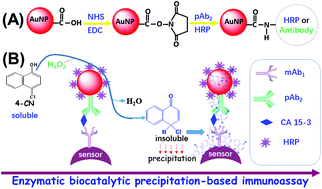A novel potentiometric immunoassay for carcinoma antigen 15-3 by coupling enzymatic biocatalytic precipitation with a nanogold labelling strategy
Abstract
Methods based on potentiometric measurement have been developed for immunoassays, but most exhibit low sensitivities and are unsuitable for early diagnosis of disease. Herein we design a new potentiometric immunosensing platform for the sensitive detection of carcinoma antigen 15-3 (CA 15-3) by coupling with enzymatic biocatalytic precipitation and a nanogold labeling technique. The sandwich-type immunoreaction is carried out on a monoclonal anti-CA 15-3 capture antibody-modified working electrode, using horseradish peroxidase (HRP) and polyclonal anti-CA 15-3 detection antibody-labeled gold nanoparticles. Upon the introduction of target CA 15-3, the carried HRP molecules with an immunocomplex catalyze the oxidation of 4-chloro-1-naphthol (4-CN) into the insoluble benzo-4-chlorohexadienone. The formed product coated on the surface of the modified electrode results in a change of the electrical potential. Under optimal conditions, the shift in the electrical potential relative to the background signal increases with the increasing target CA 15-3 concentration, and exhibits a good linear relationship within the dynamic range of 0.01–30 U mL−1 at a detection limit of 7.8 mU mL−1. Good precision and reproducibility, and high specificity were acquired for the analysis of 15 human serum specimens, giving well matched results with those obtained from a human CA 15-3 ELISA kit.



 Please wait while we load your content...
Please wait while we load your content...